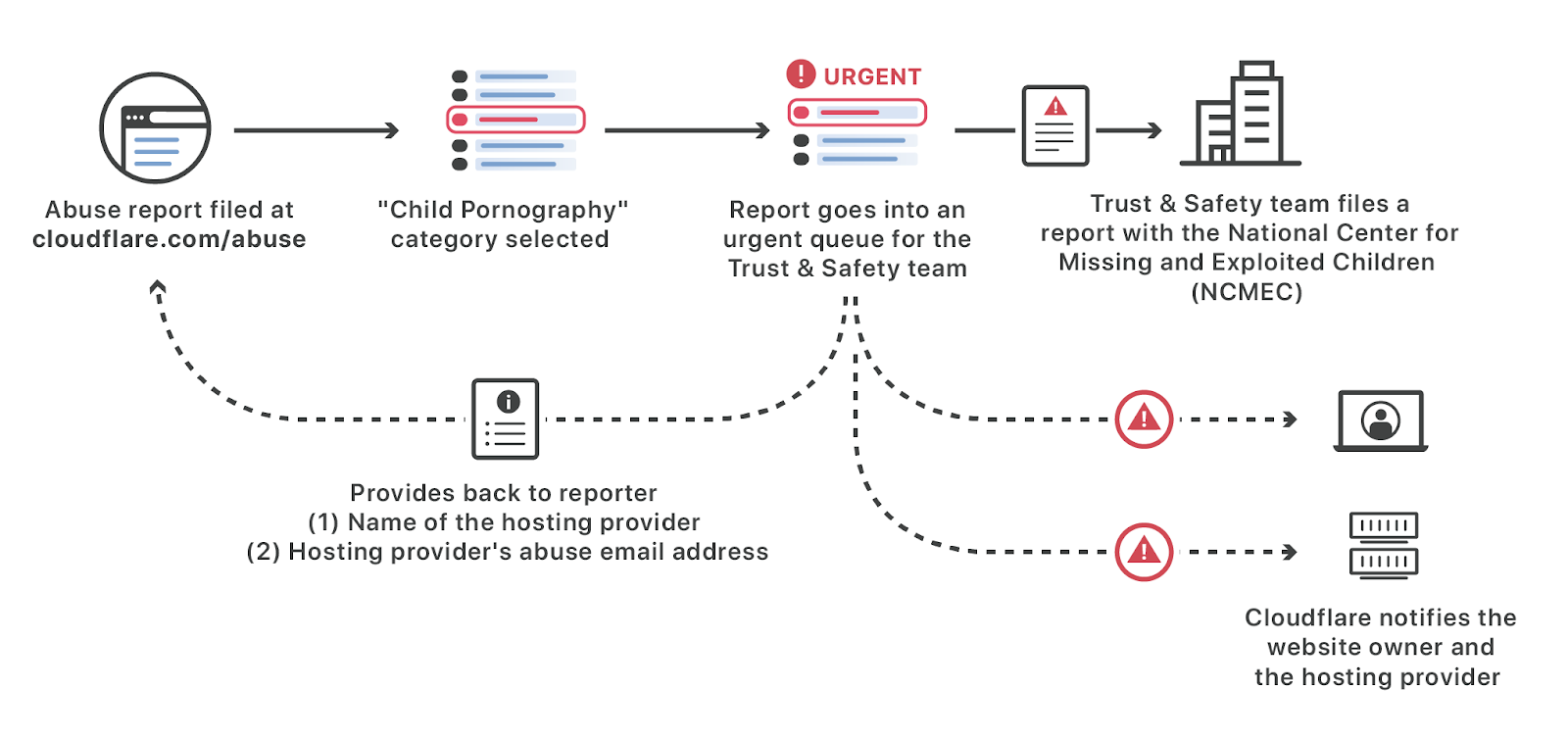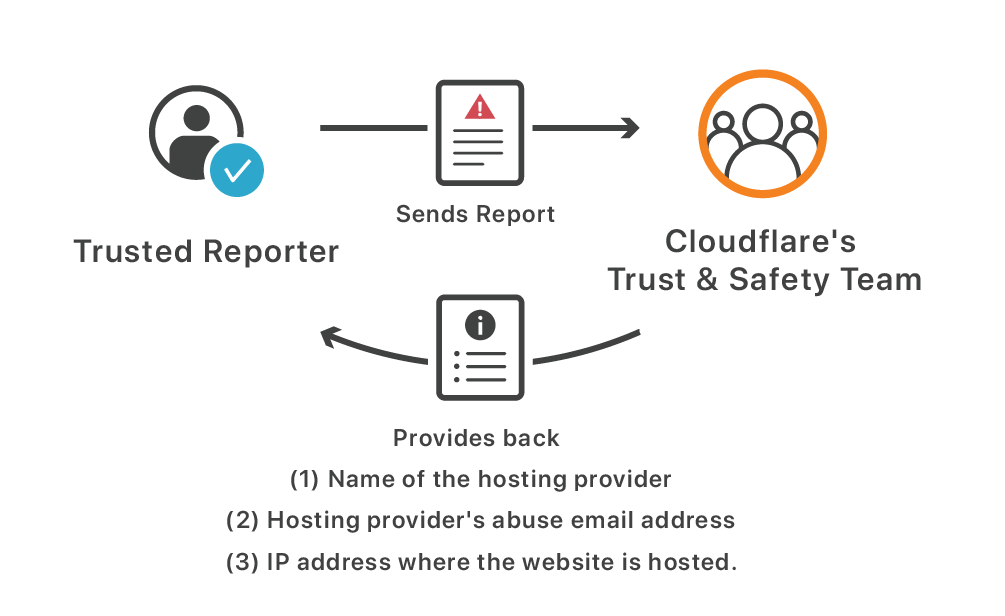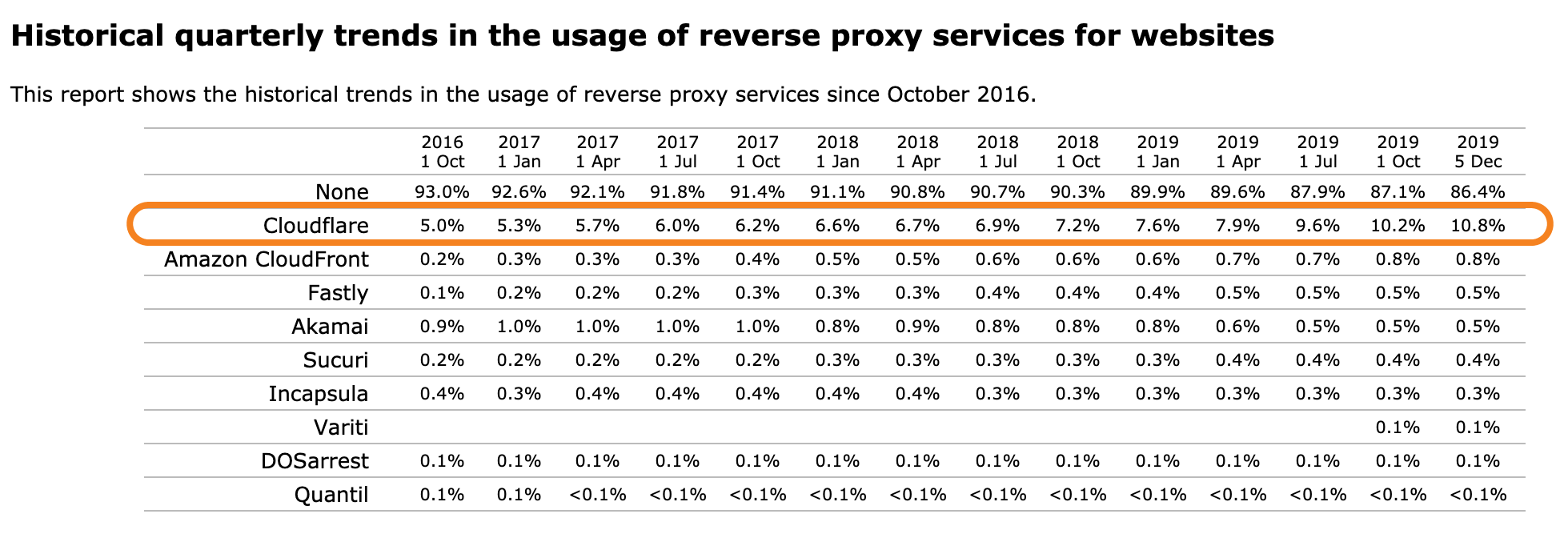Responding to incidents of child sexual abuse material (CSAM) online has been a priority at Cloudflare from the beginning. The stories of CSAM victims are tragic, and bring to light an appalling corner of the Internet. When it comes to CSAM, our position is simple: We don’t tolerate it. We abhor it. It’s a crime, and we do what we can to support the processes to identify and remove that content.
In 2010, within months of Cloudflare’s launch, we connected with the National Center for Missing and Exploited Children (NCMEC) and started a collaborative process to understand our role and how we could cooperate with them. Over the years, we have been in regular communication with a number of government and advocacy groups to determine what Cloudflare should and can do to respond to reports about CSAM that we receive through our abuse process, or how we can provide information supporting investigations of websites using Cloudflare’s services.
Recently, 36 tech companies, including Cloudflare, received this letter from a group of U.S Senators asking for more information about how we handle CSAM content. The Senators referred to influential New York Times stories published in late September and early November that conveyed the disturbing number of images of child sexual abuse on the Internet, with graphic detail about the horrific photos and how the recirculation of imagery retraumatizes the victims. The stories focused on shortcomings and challenges in bringing violators to justice, as well as efforts, or lack thereof, by a group of tech companies including Amazon, Facebook, Google, Microsoft, and Dropbox, to eradicate as much of this material as possible through existing processes or new tools like PhotoDNA that could proactively identify CSAM material.
We think it is important to share our response to the Senators (copied at the end of this blog post), talk publicly about what we’ve done in this space, and address what else we believe can be done.
How Cloudflare Responds to CSAM
From our work with NCMEC, we know that they are focused on doing everything they can to validate the legitimacy of CSAM reports and then work as quickly as possible to have website operators, platform moderators, or website hosts remove that content from the Internet. Even though Cloudflare is not in a position to remove content from the Internet for users of our core services, we have worked continually over the years to understand the best ways we can contribute to these efforts.
Addressing Reports
The first prong of Cloudflare’s response to CSAM is proper reporting of any allegation we receive. Every report we receive about content on a website using Cloudflare’s services filed under the “child pornography” category on our abuse report page leads to three actions:
- We forward the report to NCMEC. In addition to the content of the report made to Cloudflare, we provide NCMEC with information identifying the hosting provider of the website, contact information for that hosting provider, and the origin IP address where the content at issue can be located.
- We forward the report to both the website operator and hosting provider so they can take steps to remove the content, and we provide the origin IP of where the content is located on the system so they can locate the content quickly. (Since 2017, we have given reporting parties the opportunity to file an anonymous report if they would prefer that either the host or the website operator not be informed of their identity).
- We provide anyone who makes a report information about the identity of the hosting provider and contact information for the hosting provider in case they want to follow up directly.
Since our founding, Cloudflare has forwarded 5,208 reports to NCMEC. Over the last three years, we have provided 1,111 reports in 2019 (to date), 1,417 in 2018, and 627 in 2017.
Reports filed under the “child pornography” category account for about 0.2% of the abuse complaints Cloudflare receives. These reports are treated as the highest priority for our Trust & Safety team and they are moved to the front of the abuse response queue. We are generally able to respond by filing the report with NCMEC and providing the additional information within a matter of minutes regardless of time of day or day of the week.

Requests for Information
The second main prong of our response to CSAM is operation of our “trusted reporter” program to provide relevant information to support the investigations of nearly 60 child safety organizations around the world. The "trusted reporter" program was established in response to our ongoing work with these organizations and their requests for both information about the hosting provider of the websites at issue as well as information about the origin IP address of the content at issue. Origin IP information, which is generally sensitive security information because it would allow hackers to circumvent certain security protections for a website, like DDoS protections, is provided to these organizations through dedicated channels on an expedited basis.
Like NCMEC, these organizations are responsible for investigating reports of CSAM on websites or hosting providers operated out of their local jurisdictions, and they seek the resources to identify and contact those parties as quickly as possible to have them remove the content. Participants in the “trusted reporter” program include groups like the Internet Watch Foundation (IWF), the INHOPE Association, the Australian eSafety Commission, and Meldpunt. Over the past five years, we have responded to more than 13,000 IWF requests, and more than 5,000 requests from Meldpunt. We respond to such requests on the same day, and usually within a couple of hours. In a similar way, Cloudflare also receives and responds to law enforcement requests for information as part of investigations related to CSAM or exploitation of a minor.

Among this group, the Canadian Centre for Child Protection has been engaged in a unique effort that is worthy of specific mention. The Centre’s Cybertip program operates their Project Arachnid initiative, a novel approach that employs an automated web crawler that proactively searches the Internet to identify images that match a known CSAM hash, and then alerts hosting providers when there is a match. Based on our ongoing work with Project Arachnid, we have responded to more than 86,000 reports by providing information about the hosting provider and provide the origin IP address, which we understand they use to contact that hosting provider directly with that report and any subsequent reports.
Although we typically process these reports within a matter of hours, we’ve heard from participants in our “trusted reporter” program that the non-instantaneous response from us causes friction in their systems. They want to be able to query our systems directly to get the hosting provider and origin IP information, or better, be able to build extensions on their automated systems that could interface with the data in our systems to remove any delay whatsoever. This is particularly relevant for folks in the Canadian Centre’s Project Arachnid, who want to make our information a part of their automated system. After scoping out this solution for a while, we’re now confident that we have a way forward and informed some trusted reporters in November that we will be making available an API that will allow them to obtain instantaneous information in response to their requests pursuant to their investigations. We expect this functionality to be online in the first quarter of 2020.
Termination of Services
Cloudflare takes steps in appropriate circumstances to terminate its services from a site when it becomes clear that the site is dedicated to sharing CSAM or if the operators of the website and its host fail to take appropriate steps to take down CSAM content. In most circumstances, CSAM reports involve individual images that are posted on user generated content sites and are removed quickly by responsible website operators or hosting providers. In other circumstances, when operators or hosts fail to take action, Cloudflare is unable on its own to delete or remove the content but will take steps to terminate services to the website. We follow up on reports from NCMEC or other organizations when they report to us that they have completed their initial investigation and confirmed the legitimacy of the complaint, but have not been able to have the website operator or host take down the content. We also work with Interpol to identify and discontinue services from such sites they have determined have not taken steps to address CSAM.
Based upon these determinations and interactions, we have terminated service to 5,428 domains over the past 8 years.
In addition, Cloudflare has introduced new products where we do serve as the host of content, and we would be in a position to remove content from the Internet, including Cloudflare Stream and Cloudflare Workers. Although these products have limited adoption to date, we expect their utilization will increase significantly over the next few years. Therefore, we will be conducting scans of the content that we host for users of these products using PhotoDNA (or similar tools) that make use of NCMEC’s image hash list. If flagged, we will remove that content immediately. We are working on that functionality now, and expect it will be in place in the first half of 2020.
Part of an Organized Approach to Addressing CSAM
Cloudflare’s approach to addressing CSAM operates within a comprehensive legal and policy backdrop. Congress and the law enforcement and child protection communities have long collaborated on how best to combat the exploitation of children. Recognizing the importance of combating the online spread of CSAM, NCMEC first created the CyberTipline in 1998, to provide a centralized reporting system for members of the public and online providers to report the exploitation of children online.
In 2006, Congress conducted a year-long investigation and then passed a number of laws to address the sexual abuse of children. Those laws attempted to calibrate the various interests at stake and coordinate the ways various parties should respond. The policy balance Congress struck on addressing CSAM on the Internet had a number of elements for online service providers.
First, Congress formalized NCMEC’s role as the central clearinghouse for reporting and investigation, through the CyberTipline. The law adds a requirement, backed up by fines, for online providers to report any reports of CSAM to NCMEC. The law specifically notes that to preserve privacy, they were not creating a requirement to monitor content or affirmatively search or screen content to identify possible reports.
Second, Congress responded to the many stories of child victims who emphasized the continuous harm done by the transmission of imagery of their abuse. As described by NCMEC, “not only do these images and videos document victims’ exploitation and abuse, but when these files are shared across the internet, child victims suffer re-victimization each time the image of their sexual abuse is viewed” even when viewed for ostensibly legitimate investigative purposes. To help address this concern, the law directs providers to minimize the number of employees provided access to any visual depiction of child sexual abuse.
Finally, to ensure that child safety and law enforcement organizations had the records necessary to conduct an investigation, the law directs providers to preserve not only the report to NCMEC, but also “any visual depictions, data, or other digital files that are reasonably accessible and may provide context or additional information about the reported material or person” for a period of 90 days.

Because Cloudflare’s services are used so extensively—by more than 20 million Internet properties, and based on data from W3Techs, more than 10% of the world’s top 10 million websites—we have worked hard to understand these policy principles in order to respond appropriately in a broad variety of circumstances. The processes described in this blogpost were designed to make sure that we comply with these principles, as completely and quickly as possible, and take other steps to support the system’s underlying goals.
Conclusion
We are under no illusion that our work in this space is done. We will continue to work with groups that are dedicated to fighting this abhorrent crime and provide tools to more quickly get them information to take CSAM content down and investigate the criminals who create and distribute it.
Cloudflare's Senate Response (PDF)
Cloudflare's Senate Res... by Cloudflare on Scribd


